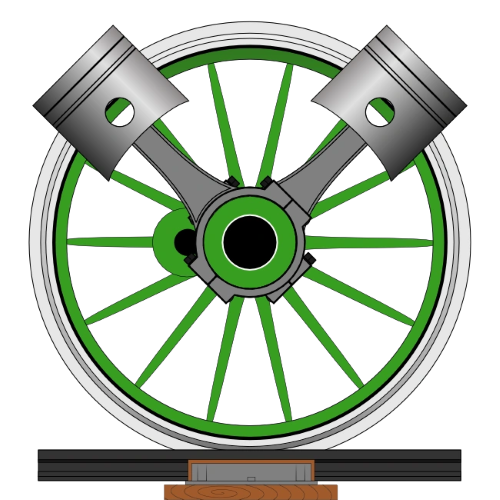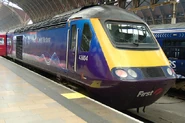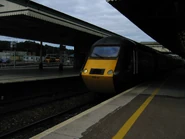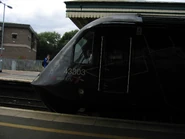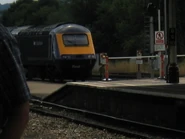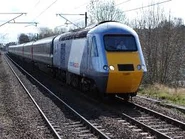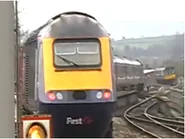The British Rail Class 43 (HST) is the TOPS classification for the InterCity 125 (Formerly Class 253 and Class 254) powercars, built by BREL (British Rail Engineering Limited) at their Crewe Works from 1975-1982. 197 powercars were produced in total. The Class 43 powercars and their MK 3 coaches (Together forming Intercity 125/HST sets) were introduced as a stop-gap measure until electrification of the East Coast and West Coast Main Lines was completed and the APT (Advanced Passenger Train) introduced. However, with the cancellation of the APT, due to an embarrassing failure of the tilting system with members of the British press onboard, the Class 43 powercars became the jewel in the British Rail crown, serving from Inverness in the Highlands of Scotland to Penzance in the far southwest of England. The oldest powercar, 43002 is 47 years old (as of 2022), and has now been withdrawn from service, and placed on static display at the National Railway Museum in York, as part of the National Collection. To this day the Class 43 along with their matching MK3 coaches are considered the greatest achievement in British Railway history. The Class 43 is officially the fastest diesel locomotive in the world. This record was set in 1987 when an Eastern Region Intercity 125 set with powercar 43159 leading set the record of 148.5 mph while working the, Up (southbound), Tees-Tyne Pullman between Darlington and York, arriving in to York to huge fanfare complete with brass band, before continuing on to London Kings Cross. 43159 is still in operation, as of 2015, with First Great Western. There have been two unverified claims of faster speeds attained by a diesel locomotive. The Russian TEP80 claiming a speed of 168 mph, and the Spanish Talgo XXI claiming, 158 mph.
The Class 43 powercars are often called the HST (High Speed Train) due to their speed. Their nickname with drivers and rail enthusiasts is "Racehorse".
Specifications[]
- Power Type: Diesel.
- Service Speed: 125 mph (201kph)
- Maximum Speed: 148.5 mph (239kph)
- Current Prime Movers: MTU 16V400R41 or Paxman 12VP185
- Original Prime Mover: Paxman 12RP200L
- Experimental Prime Movers: Mirrlees & Blackstone MB190 or Paxman 12VP185L (neither currently fitted)
- Prime Mover Output: 1,677.8KW (2,250BHP)
- Power At Rail: 1,319.9KW (1,770BHP)
- Alternator: Brush Traction BA1001B on Valenta, and VP185 powered units, and Brush Traction BA1001C on MTU powered units.0
- Tractive Effort: 17,890Lb/f 80kn Maximum, 10,340 Lb/f 46kn Continuous
- Trac Motors: GEC-G417AZ on units 43124-43152), Brush Traction -TMH68-46 On Remaining Units. Four of, frame mounted.
- Transmission: Diesel engine driven alternator and rectifier feeding DC current to traction motors.
- Train Heat: ETH Index 90 (450KW from auxiliary alternator) Industrial 415V Three Phase System.
- Loco Brake Force: 35 long tons (349Kn)
- Brake Type: Air, Westinghouse
- Multiple Working: Within Class Only
- Wheel Arrangement: BO-BO.
- Wheel Diameter: 3 ft 4inches (1,016mm)
- Gauge: Standard gauge - 1,435mm - 4 ft 8.5inches.
- Bogie Type: BT10
- Length over coupling faces: 17.79 metres (58.4 ft)
- Weight Gross: 70.25 -73 metric tonnes
- Axle Load: 17.5 - 18.25 metric tonnes
- Route Availability: Class 5
- Fuel Capacity: 990ImpGal \ 1190 US Gal \ 4500Litre
- Fuel: Ultra Low Sulphur Diesel \ ULSD
- Current Operators: Great Western Railway, Arriva Cross Country, East Midland Railway, Network Rail, Scotrail, Locomotive Services Limited, Colas Rail.
- Former Operators: British Rail, Virgin Trains West Coast, Virgin Trains Cross Country, Great North Eastern Rail, London North Eastern Railway, Grand Central, Hull Trains, Midland Mainline, East Midland Trains, First Great Western, and Great Western Trains.
- Family Name: HST. Along with the Australian XPT Powercars "StraightFace", and the Prototype HST Powercars (Class 41).
History and Background[]
In the early 1970's the British Railways Board (BRB), decided to replace its main line diesel traction. Finances were tight at the time a mass electrification was not an immediate option. Therefore, a new generation of high-speed diesel traction had to be developed. A the time British Railways was experiment with the electric and the gas turbine versions of the Advanced Passenger Train (APT). However the APT was ultimately a failure after the tilting mechanism got jammed at high speed, with members of the British Press onboard causing, nausea and vomiting for those onboard, leading to negative publicity and killing the APT project. When the APT project failed the HST became the flagship of British Rail.
Experience with the 100 mph Class 55 "Deltic" locomotives on the East Coast Main Line showed that low axle weight and a high speed engine where essential to avoiding track damaged at sustained high speed, and to provide a high enough power to weight ratio. To power the HST the Class 43 powercars were fitted with a Paxman Valenta 12RP200L diesel engine developing 2,250 bhp at 1,500rpm. A 70 metric tonne weight gave the powercars a 17.5 metric tonne axle load.
Development and Design[]
The prototype HST (Class 41 powercars and MK3 coaches) were designed and developed at the Railway Technical Centre at Derby by Terry Miller. The powercars been constructed at BREL's Crewe Works and the MK3 coaches at Derby Litchurch Lane Works. The engine used in the prototype powercars was the same Paxman Valenta 12RP200L used later in the production powercars. The electrical equipment used in the prototype powercars was produced by Brush Traction of Loughborough. The prototype powercar had a central drivers position at the aerodynamically designed front end, with an auxiliary/shunting position at the blunt/gangway end. The auxiliary position was dropped from the production powercars. The aerodynamically shaped front was also change for the production units.
The two prototype powercars emerged from Crewe works in July and August 1972 and were originally designated Class 41, numbered 41001 and 41002. But, after a short period, the whole set including the MK3 passenger trailer were designated Class 252 and been classified as a diesel multiple unit (DMU). The powercars were given the coaching stock numbers 43000 and 43001. After a proving period on the Eastern Region the High Speed Diesel Train (HSDT), was transferred to the Western Region were it was used on London Paddington to Bristol and Weston Super Mare services.
During the prototypes time on the Eastern Region, it set the world speed record for diesel traction of 143.8 mph between York and Darlington. This record has only been surpassed by the production power number 43159 at 148.5 mph. The driver noted that he believed that the prototype could well have reached 180 mph with enough track as the powercars had plenty of power to spare.
The prototype HST proved very successful and led to an order for 197 production power cars for the Eastern, Western, Scottish, and London Midland Regions. The construction of the production powercars and the HST version of the MK3 passenger coaches began in 1975, with entry into service in 1976.
The production powercars feature improvements over the prototypes, including a redesigned front end without conventional Link&Hook\L&H couplers +buffers (an emergency drawbar hidden behind a cover on the frontend can be used to haul a failed HST), 415vac3Phase Electric Train Heat\ETH instead of the prototypes conventional 1000vdc ETH; production powercars also lost the auxiliary drivers position for shunting but gained a Secondmans position in a redesigned cab (due to union issues).
With the completion of the production HSTs in 1982, the prototype was withdrawn from service. The powercars passed to the Research Division in Derby. Of the ten prototype MK3 passenger trailers, two were converted for use in the Royal Train, five were modified to work with the production powercars, and three were transferred to departmental stock.
197 production powercars were produced, numbered 43002-43198. 43001 was applied to the second of the prototype units, while the first prototype powercar was numbered 43000. 43000 had recently been returned to working order by the 125 Group under the banner of Project Miller named after Terry Miller, the designer of the HST. 43001 was scrapped after withdrawal in 1990.
Intercity 125[]

Prototype HST powercar 41001 (later 43000) at the National Railway Museum in York.
The Intercity 125 is a train set originally classified as a Diesel Multiple Unit (DMU) of Classes 253 (Western Region), and 254 (Eastern, Scottish and London Midland Regions), and consist of two Class 43 powercar sandwiching up to nine MK3 passenger trailers. The Intercity 125 is no longer classified as a DMU and is now considered to be a locomotive hauled train in top and tail configuration (one powercar at each end). On introduction the Class 43 was matched with seven MK3 trailers on the Western Region, and eight MK3 trailers on the Eastern, Scottish and London Midland Regions. Today Intercity 125 sets are operated in 2+6 configuration with Grand Central, 2+7 with Arriva Cross Country, 2+8 with First Great Western and East Midland Trains, and 2+9 by East Coast. Former Operator Virgin Cross Country operated 2+5 sets to match their Class 220 and 221 Voyager and Super Voyager sets for acceleration. 2+5 is the minimum allowed length for running at 125 mph due to braking issues on shorter sets. 80% of the braking power on the Intercity 125 is provided by the passenger coaches.
Buffered Powercars[]
In 1987, with the electrification of the East Coast Main Line progressing quickly, British Rail realised that the MK4 coaches and DVT's (Driving Van Trailers) for the Class 89 and Class 91 electric locomotives would not be ready in time for the introduction of electric services on the East Coast Main Line. So, in late 1987, at total of eight Eastern Region powercars (numbers, 43013, 43014, 43065, 43067, 43068, 43080, 43084, 43123) were converted for use as surrogate DVT's for use with Class 89 and Class 91 electric locomotives.
This conversion included, removal of the lower aerodynamic valences, fitting of buffers, and fitting of TDM (Time Division Multiplexing) remote control equipment to control the electric locomotives. TDM at the time, use the cable for the lights to transmit control signals the length of the train, it now used a dedicated jumper cable for locomotive that use it.
The conversion of numbers 43013 and 43014 were conducted at the Derby Engineering Development Unit, with the conversion of numbers 43065, 43067, 43068, 43080, 43084, and 43123 taking place at Stratford Diesel Repair Shop in London. After conversion these powercars entered service as surrogate DVT's, working with Class 89 and Class 91 locomotives on London Kings Cross to Leeds services providing Electric Train Heating for the MK3 coaches. At first the powercars were left idling and only provided Electric Train Heating. However the prolonged idling cause excess oil to build up in the exhaust system, and after several powercar fires, the powercar were allowed to provide extra traction power to the train creating the most powerful train in the UK at the time at over 8,000 bhp.
After the MK4 coaches and DVT's arrived in 1991, the converted powercars were no longer needed on DVT duties and had the TDM system removed but retain their buffers to this day. After privatization of British Rail, these powercars worked for Virgin Cross Country and Virgin West Coast, where they displaced older loco- hauled stock. Virgin gave up their HST sets when new Class 220 and 221, Voyager and Super Voyager Sets were introduced, with the last Virgin HST service operating in late 2003. Nearly all of these powercars were then stored at MOD Long Marston. After several years of storage, several of these powercars were leased by Midland Main Line for their "Project Rio", special services from London St Pancras to Manchester Piccadilly, while major engineering works were undertaken on the West Coat Main Line. The powercars where kept in de-branded Virgin Trains livery throughout their time with Midland Main Line and were returned to storage after Project Rio ended in 2006.
In 2003 infrastructure owner Network Rail bought powercars 43013, and 43014 for use of their track recording train called The New Measurement Train (NMT). Both of these powercars were refitted in 2010 with MTU 16V400R41 prime movers to increase reliability, reduce fuel consumption, and reduce emissions.
43067 and 43080 were leased the GNER (Great North Eastern Railway) as spare powercars, that could be quickly called upon in the event of a failed powercar. These powercars where repainted into GNER livery and were based at Craigentinny Depot in Edinburgh. The lease of these locomotives ended in 2006 and they returned to storage at Long Marston.
In 2007, Open Access Operator, Grand Central, voiced interest in acquiring the stored powercars for the planned services from London Kings Cross to Sunderland. In total 43067, 43068, 43080, 43084, and 43084 were bought by the company and now run high speed services between London Kings Cross and Sunderland. Numbers 43084 and 43123 where the last powercars still operating with their original Paxman Valenta 12RP200L engine. After several special enthusiast runs in honour of the Valenta Engine, they where re-engineered at Brush Traction in Loughborough in 2010, been fitted with a new MTU 16V4000R41 engines. During re-engineering, all Grand Central powercars were repainted into Grand Central's new black with orange stripe livery and were re-numbered in to the 434xx series.
Engines[]
When introduced and for much of their lives the Class 43 HST had been fitted with the, Paxman Valenta 12RP200L high speed diesel engine rated at 2,250 bhp. However the Valenta had downsides such as, been at noisy engine (popular with enthusiasts because the turbocharger screams), unreliability, susceptibility to overheating, high fuel consumption, high lube oil burning rate, and excessive smoke production. Before cooler group upgrade the engines on the Western Region powercars were temporarily downrated to 2,000 bhp during the summer months.
In 1987 British Rail experimentally fitted Western Region powercars 43167-43170 with Mirrlees and Blackstone MB-190 engine in the hope of solving some of the issues. However this trial was ultimately unsuccessful and the powercars regained their original Valenta engines.
Also in 1987, Paxman Ltd began development of the successor to the Paxman Valenta series, the Paxman VP185 series. British Rail decided to participate in a trial. The first powercars were fitted with Paxman 12VP185 engines in 1993. A qualifying requirement for the trial was that the engine should be able to go through 3,000 cycles of each of ten minutes duration. Four minutes at the maximum power of 3,500 bhp and six minutes at idle. This test was carries out from December 1993 to February 1994 by British Rail and pushed the engines far harder than they ever would in service, as in service they would be rated at 2,250 bhp. The success of these test cleared the way for 43170 to be fitted with a VP185 for in depot trials and the powercar entered main line service with its new engine on 22 September 1994, and named "Edward Paxman".
During the late 1990s twenty-five HST power cars were re-engined with Paxman 12VP185L engines in order to improve fuel consumption and reduce emissions, but these engines have proved less reliable in service than hoped. However, the 12VP185L was introduced fleet-wide within the Australian XPT powercars.
In 2004, First Great Western and leasing company Angel Trains, decided to seek a replacement for the Paxman Valenta and the VP185. The main reason been to rectify chronic reliability problems plaguing their powercars, but also to life extend the units and to reduce fuel consumption and exhaust emissions. In 2004 German engine manufacturer MTU were selected to supply the new engines designated, MTU 16V4000R41. After a year long trial period First Great Western decide to roll out the MTU 4000 fleet wide and by 2009 all of their powercars had been fitted with them at Brush Traction in Loughborough. A the same time First Great Western had the MK3 passenger trailers refurbished at Brush Barclay Works in Kilmarnock, Scotland.
In 2005, GNER after seeing the success of the MTU 4000 with First Great Western decide to replace the engines in their powercars with them. However GNER didn't get to see the full fleet re-engined as in 2007, GNER's parent company Sea Containers, filed for bankruptcy protection and lost the Intercity East Coast Franchise. In November 2007 the Intercity East Coast Franchise passed to National Express East Coast who continued the re-engineering program at Brush Traction. Like First Great Western, National Express East Coat decided to have its MK3 passenger trailers refurbished - this time by Wabtec Rail at their Doncaster Works, in conjunction with Bombardier Transportation. In 2009, National Express, in response to falling passenger numbers and falling profits, refused to continue funding the Intercity East Coast franchise and was stripped of the franchise by the Department for Transport. The Department for transport set up the publicly own company "Directly Operated Railways" who have run the Intercity East Coast from November 2009, and will do so until March 2015 when the franchise will be reprivatized and handed over to Virgin Trains East Coast, a consortium of Virgin Group and Stagecoach. The last of the East Coast Powercars had been re-engined by the end of 2009.
When the Cross Country franchise passed from Virgin Cross Country to Arriva Cross Country in 2007, Arriva decide to re-introduce HST's to it's fleet in response to passenger feedback and over-crowding. Virgin Cross Country had dropped the HST's in 2003 in favor of Class 220 and 221 Voyager and Super Voyager DMU's, a move that proved highly unpopular with passengers who found the new trains, noisy, rough riding, cramped and uncomfortable compared to the HST's they replaced. The new trains also had far fewer seats than the HST's they replace leading to chronic over-crowding on core routes.
In 2008 Arriva re-introduced five HST sets into service having (buffer stop) had the powercars overhauled and fitted with MTU 4000 engines. To facilitate this a number of non HST MK3 coaches had their electrical systems and couplers modified to work with the HST powercars. The coaches also had their buffers removed.
In 2008, Network Rail fitted its two powercars used on the New Measurement Train with MTU 4000 engines.
In 2009, Open Access Operator, Grand Central announced that it would be replacing the Paxman Valenta engines in its powercars with the MTU 4000 engine. The last powercars to retain the Valenta engines, numbers 43084 and 43123 ran several special trains for enthusiasts in 2010 before heading to Brush Traction for reengineering.
There are now no production powercars that retain their original Valenta Engines as East Midland Trains elected to replace theirs with the VP185 in 2009. The prototype powercar 43001, is currently undergoing overhaul to return it to main line operation on railtours and has been fitted with an Paxman Valenta engine taken form a First Great Western powercar during the re-engineering programme.
World Speed Record for Diesel Traction[]
On Sunday the 1st November 1987, British Rail decided to push the HST as far as they could. As specially selected HST set was prepared at Craigentinny Depot in Edinburgh. The set was shorted to 2+5 formation and consisted of, 43159 (leading), five Mk3 coaches, and 43104 (trailing). The Mk3 Coaches had been fitted with a new type of bogie, the Swiss built SIG BT41. These bogies would later be used under the MK4 coaches hauled by Class 91 electric locomotives. The train departed Craigentinny and headed to Newcastle as an empty coaching stock move. After boarding VIP passengers at Newcastle, the train headed south on a service to London Kings Cross with the named train, "The Tees-Tyne Pullman". After a stop at Darlington, the train accelerated quickly, however was checked to 80 mph on a sharp curve about five miles south of Darlington. Afterward, the train again accelerated hard, passing Northallerton at 140 mph. Acceleration slowed, but just south of Thirsk, the train was timed over a measured mile at having attained or exceeded 148 mph, later verified to have attained 148.5 mph. The train proceeded south to York and on to London Kings Cross limited for this part of the journey to 125 mph. After this record run it was noted by the driver that the train seemed to have plenty of power to spare and thought that, with enough track he could have attained 180 mph. In the passenger coached it has noted that the new SIG- BT41 bogies were giving a particularly rough ride. It was later found that deficiencies in the primary suspension and in the yaw dampers was causing the coach bodies to impact the bogie frames at high speed on anything but dead straight, continuously welded rail. The two record breaking Class 43's are still in service today. Number 43159 is operating with First Great Western and operated services from London Paddington to Bristol, Cardiff, Swansea, Exeter, Plymouth, and Penzance, while number 43104 has been renumbered as 43304, and operates with East Coast between, London Kings Cross, Leeds, Harrogate, Skipton, Hull, Newcastle, Edinburgh, Glasgow, Aberdeen, and Inverness, and passed the site of the record run almost everyday.
Hybrid Trial[]
In 2007, Brush Traction and Hitachi equipped Paxman Valenta powered 43089 and a semi-permanently coupled MK3 coach with a diesel hybrid electric power system. The powercar was named Hayabusa (Japanese for Peregrine Falcon), and operated the Network Rail, New Measurement Train. The powercar has since been refitted with a VP185 engine and returned to normal service with East Midland Trains.
Project Miller[]
In May 2011 the National Railway Museum (NRM) announced that the remaining HST prototype power car 41001 would undergo full restoration work. A long-term loan was agreed between the NRM and the 125 Group of volunteers for the locomotive and a Paxman Valenta RP200L engine. The replacement engine (no. S508) was required as the original Valenta engine (no. S183) had been sectioned for display purposes. The S508 engine was lifted into the locomotive at Neville Hill depot on 29 June 2012.
In order to facilitate a main line move, Class 41 prototype HST power car 41001 was re-registered as a Class 43/9 locomotive, with the number 43000. It is the only locomotive in this sub-class.
Current Operations[]
As of 2020, the Class 43 is still in use with the Great Western Railway, Abellio ScotRail, Arriva CrossCountry, East Midlands Railway, Locomotive Services Limited, and Colas Rail.
In October 2017, the Great Western Railway began to replace its HST sets with new Hitachi Class 800 trains on its long distance, intercity services. The last four Great Western Railway intercity HST services left London Paddington on 18 May 2019 as the 18:03 London Paddington to Plymouth, 18:15 London Paddington to Cheltenham Spa, 18:22 London Paddington to Hereford, and the 18:30 London Paddington to Taunton (extended to Exeter St David's). Great Western Railway do still operated HST's as of 2020, but only as shortened 2+4 Class 255 "Castle Sets" which are used on local, and regional services in South-west England, and South Wales. Great Western Railway has fitted it's Mk3 Coaches with power doors, controlled emissions toilets, retention tanks, and disabled access toilets to meet TSI-PRM requirements.
Abellio Scotrail operate 27 HST sets in 2+4, and 2+5 formations. These sets are known as Inter7City, and are used on services from Edinburgh, and Glasgow to Aberdeen, and Inverness, and from Aberdeen to Inverness. These sets have being fitted with controlled emissions toilets, retention tanks, disabled access toilets, and power door to meet TSI-PRM legislation. The Scotrail HST's are former Great Western Railway set, and were refurbished, and converted at Wabtec Rail, Doncaster. One Scotrail 2+4 set is currently out of service after being involved in a fatal collision, and derailment on the 12th August 2020. Scotrails HST's are based at Edinburgh's Haymarket Depot, with maintenance also carried out at Inverness Depot, and Aberdeen Clayhills.
Arriva Cross Country currently operate five HST sets in 2+7 formation on peak-time, heavily loaded services form Leeds and York to Plymouth, as well as Glasgow, Edinburgh, and Dundee to Plymouth services. All sets have been fitted with controlled emission toilets, retention tanks, disabled access toilets, and power doors to meet TSI-PRM legislation.
East Midlands Railway currently operate twelve HST set with nine sets in 2+8 formation, and three sets in 2+6 "fun size" formation. It uses these set on semi-fast intercity services from London St Pancras to Leeds, Nottingham, and some London St Pancras to Sheffield services. During the summer, EMR also used to operate Saturday services from Nottingham to Skegness using a HST set. EMR currently uses just nine of it's own powercars, 6 of which are fitted with buffers from the DVT project in the 1980's, and 1990's. The rest of their HST Power Car fleet are former LNER Power Cars, hauling a mix of EMR, and former LNER Mk3 coaches. As of the 11th December 2020, all of the VP185 HSTs are now out of service. Soon all of EMR's HST Sets will be replaced in 2022 by Hitachi Class 810 "Aurora" Bi-mode Trains.
Locomotive Services Limited currently operate a fleet of five powercars numbered 43046, 43055, 43058, 43059, and 43083. It also has a fleet of thirteen HST MK3 Coaches. 43056, 43055, and 9 MK3's have being formed into a 2+9 "Jumbo" set, refurbished and reliveried into the all first class, Midland Pullman Charter Train. 43058, 43059, and the remaining four MK3's are currently used for driver training on the West Coast Mainline. 43089 is currently at Eastleith Depot in Hampshire, and is expected to be refurbished, reliveried, and modified to become a spare powercar for the Midland Pullman. The Midland Pullman Powercars have been modified to include high output headlight, marker lights (including third marker light), and tail lights. This mean that the Midland Pullman does not have, or need the yellow warning panel on the front of its Power Cars. The Midland Pullman will operate for the first time on 12 December 2020.
Colas Rail currently operate a fleet of two former East Midland Railway power cars, and a rake of 4 Mk2 coaches. These two powercars are numbers 43050, and 43060. These are currently used on Network Rail Test Trains, and are being assessed for their environmental properties, with a view to replacing the Coals Rail Class 37's. 43060 has being noted to have problems with the cylinder seals of it's VP185 engine, making the power car extremely smokey in service. Note that while the Class 43 can hauls MK2 coaches using its AAR coupler, it cannot supply ETS power as the MK2 coaches use standard 1000v DC supply. One of the MK2 coaches is fitted with its own ETS generator.
Past Operations[]
British Rail[]
The Class 43 was originally introduced into service by British Rail in 1976 on its Great Western Mainline services from London Paddington to Bristol, Taunton, Exeter, Plymouth, Truro, Penzance, Cardiff, and Swansea. Termed the Intercity 125 these HST's were formed into 2+7 sets. These sets were, at the time considered to be Diesel Multiple Unit Trains of fixed formation, and designated as Class 253. In the coming years, services on the Great Western Mainline were extended to include services to Hereford, Cheltenham, Paignton, and Oxford.
Similar set were introduced to the East Coast Mainline in 1978. These sets were extended to 2+8 formation, and designated as Class 254. These units operated from London King's Cross to end destinations such as Leeds, Newcastle, Edinburgh, Hull, Bradford, Skipton, Cleethorpes, Inverness, and Aberdeen. The East Coast HST relegated the 100 mph Deltic locomotives to secondary services, and led to their eventual retirement in January 1982.
British Rail's Midland Mainline, and Cross Country services also received allocations of HST's in the coming years.
Due to the differing maintenance requirements between powercars and coaches, it was soon found to be impractical to continue to view the Class 253, and 254 HST's as fixed formation trains. Therefore the trains were redesignated as locomotives, and hauled passenger stock. This created the TOPS designation of Class 43 for the HST powercars from their former 43xxx series carriage numbers.
Between 1993, and 1997 British Rail was sold into privatization. Most Class 43's went to the new franchises, however some were in poor condition and were put into store. These stored powercars were reactivated at various stages.
LNER[]
LNER (London North Eastern Railway) no longer operate the HST as of 21 December 2019, having replaced all of their HST sets with Hitachi Class 800 Bi-mode trains. Their last HST service was the 19:35 London King's Cross to Leeds service on 15 December 2019. A Few days later a 4 day charity railtour ran on the ECML for the very last time ending at Kings Cross on the 21st December 2019. Previous to this LNER operated thirteen 2+9 (Jumbo) sets, and one 2+8 former East Midland Trains set. Their HST's operated services to destinations off of the electrified East Coast Mainline, from London King's Cross to Lincoln, Kingston upon Hull, Harrogate, Sunderland, Stirling, Inverness, and Aberdeen. and also on the once daily Leeds to Aberdeen, and return. Their HST's also supplemented their Class 91 electric locomotives, on the fully electrified London King's Cross to Newark North Gate, York, Leeds, Bradford Forster Square, Skipton, Newcastle, and Edinburgh Waverley services. LNER's HST's also deputized for Class 91's on many occasion in normal service, and on diversions due to engineering works. Other destinations served by LNER HST's were, Stevenage, Peterborough, Grantham, Retford, Doncaster, Wakefield Westgate, Shipley, Keighley, Selby, Brough, Northallerton, Darlington, Durham, Morpeth, Alnmouth, Berwick upon Tweed, Dunbar, Haymarket, Inverkeithing, Kirkaldy, Dundee, Arbroath, Montrose, Stonehaven, Falkirk Grahamston, Gleneagles, Perth, Dunkeld and Birnam, Pitlochry, Blair Atholl, Newtonmore, Kingussie, Aviemore, and Carrbridge. LNER's HST's were maintained primarily at Craigentinny depot in Edinburgh, with more minor work carried out at Bounds Green in London, Neville Hill in Leeds, Heaton in Newcastle, Clayhills in Aberdeen, and Inverness Depot.
Eurostar[]
During the mid-1990's, international rail operator Eurostar were in the process of planning for it's North of London services. These services would operate from Paris through the Channel Tunnel to Glasgow, Edinburgh, and Manchester via the East Coast, and West Coast Mainline using a dedicated fleet of Class 373/1 North of London Eurostar sets. However, in the interim period it (Flying Scotsman) was decided to run a connecting service on the West Coast Mainline from Manchester Piccadilly, and from Edinburgh Waverley via the East Coast Mainline to the Eurostar terminal at London Waterloo. This service was operated using HST's sub-leased from Intercity Cross Country, the shadow franchise which preceded Virgin Cross Country. These services were branded "Eurostar Link". However, due to very light loadings, this service ceased in January 1997.
The New Measurement Train[]
Network Rail's New Measurement Train is a specially converted InterCity 125. It can check the condition of railway lines over a 13 week cycle. On the West Coast Main Line, care is taken so tilting trains can safely run. It measures contact between wheels, rails and overhead power lines and is equipped with lasers, video cameras and other instruments. It was launched in 2003, but the vehicles used for it are older. Its yellow livery has earned it the nickname "The Flying Banana".
Replacement[]
Built between 1975 and 1982, the fleet is now in its fourth decade, and a replacement for the High Speed Train is being sought. This project, the Intercity Express Programme (originally known as the HST2), is being spearheaded by the Department for Transport. A consortium headed by Hitachi will design and build the replacement Hitachi Super Express Train. Various formations are to be built, an electric version and a bi-mode diesel-electric in 5 or 9 carriage lengths. The initial batches will replace HSTs on the Great Western Main Line and East Coast Main Line Main Lines.
On the Greater Western franchise, the current fleet of HSTs is expected to remain in service until 2017, the scheduled date for introduction of the Intercity Express. Between 12 and 20 HST sets will then be retained and refurbished to carry on providing services between London and Devon and Cornwall, where no electrification is planned, through to the mid-2020s. A 2011 report concluded that the Mark 3 coaches could remain in service as late as 2035 with some minor rewiring and enhancements required under disability legislation.
On the East Coast Main Line HST's will remain in service until 2018 before being replaced by the Hitachi Super Express.
To a lesser extent, high-speed DMUs from the Bombardier Voyager family as well as Alstom's Class 180 (Adelante) have replaced numerous HSTs, but all locomotives and sets have been brought back into service as a result of increasing demand.
In late 2014, Scotrail franchise winner Abellio, a subsidiary of the Dutch State Railway, announced that they would be leasing up to 40 Class 43 powercars released from First Great Western during the Intercity Express Programme and introducing them in 20, 2+5 sets on express passenger service from Glasgow and Edinburgh to Aberdeen and Inverness. Abellio is due to take over the Scotrail franchise from First Group in early 2015, with the HST sets been introduced in 2017.
XPT[]
In 1982, having seen the success of the Class 43 in the UK, Australia's New South Wales State Rail Authority ordered a batch of 19 powercars built to a similar design as the Class 43.
The Class 43 design was modified with a lower top speed of 100 mph and a de-rated Paxman Valenta engine of 2,000 bhp. The XPT powercars also feature revised horn and headlight clusters, and air intake filter to handle the dry dusty environment in which they operate. The XPT operates on services form Sydney to Dubbo, Grafton, Casino, Melbourne and Brisbane.
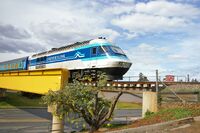
Countylink XPT
Accidents and Incident[]
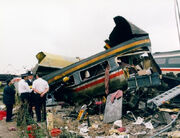
The remains of coach G of the HST.
The Southall Rail crash occurred on the Great Western Main Line at Southall, West London, on 19 October 1997. Seven people were killed and 139 injured. Great Western Trains where fined £1.5million for breaches of Health and Safety law.
The crash occurred after the 10:32 Great Western Trains passenger train from Swansea to London Paddington, worked by power cars 43173 + 43163 and operating with a defective Automatic Warning System (AWS), passed a red (danger) signal (SPAD), preceded by two cautionary signals.
As the tracks straightened ahead of him, Driver Harrison observes a Class 59 locomotive a mile in distance, moving "at a funny angle" and realised to his horror that it was crossing the Up Main. The EWS-operated freight train was coming from London on the Down Relief line, hauling twenty empty bogie hopper wagons, and permitted to cross Southall East Junction on its way into Southall Yard, south of the main lines. A collision was now inevitable. The HST was travelling at about 125 mph, could not stop in time under full braking.
Alan Bricker, the driver of the freight locomotive No. 59101, observed the approaching HST expecting it to stop, was alarmed instead at its speed and apparent brake application. In desperation, he tried to accelerate his train out of the path of the HST, but to no avail. At 13:20 local time, the Power car impacted. The engine severs the brake pipe. Causing the stranded hopper wagons to come to a halt.
The Power car, its right side destroyed, came to rest upright next to the remaining wagons. Coaches H, G and F uncoupled and derailed. Coach G and a wagon collide very heavily in an almost full frontal collision. The freight wagons were driven back and jackknife, colliding and jamming up against the nearby OLE stanchions. The result is the pinned Coach G, propelled by the vehicles behind, is severely distorted.
Six people were killed, and a seventh passenger died in hospital.
If the AWS equipment on the High Speed Train (HST) passenger train had been working, the chance of the accident occurring would have been highly unlikely, though not completely eliminated, since the AWS is only an advisory system. The driver's attention had been distracted (though no proof was ever discovered) and he did not observe the preceding signals visually, but AWS would have given him a clear audible warning, which would have required him to acknowledge the warning. Failure to acknowledge the warning would have caused the train's brakes to be applied. Automatic Train Protection (ATP) equipment would have almost certainly prevented the accident. The train was fitted with ATP but this was switched off. At the time of the accident, the ATP equipment was not required to be switched on, as it had proved troublesome in service. In addition, not all drivers had been trained on it.
As a result of the crash, all trains operating on the GWML must be fitted with an ATP system and have its AWS operational. Any train found to have defective systems are immediately taken out of service.
Leading Class 43 powercar 43173 was written off after the crash and cut up at MOD Pig's Bay in 2002. It's new VP185 engine lived on with MML.
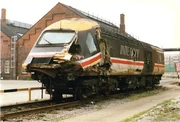
Powercar 43018 after the 1995 Royal Oak Crash. Ladbroke Grove was 43011 'Reader 125' in Fag packet.
The Ladbroke Grove rail crash (also known as the Paddington train crash) was a rail accident which occurred on 5 October 1999 at Ladbroke Grove, London, England. With 31 people being killed and more than 520 injured, this remains the worst rail accident on the Great Western Main Line. This was the second major accident on the Great Western Main Line in just over two years, the first being the Southall rail crash of September 1997, a few miles west in England. Both crashes would have been prevented by an operational Automatic Train Protection (ATP) system, but wider fitting of this had been rejected on cost grounds. This severely damaged public confidence in the management and regulation of safety of Britain's privatized railway system.
A public inquiry into the crash by Lord Cullen was held in 2000. Since both the Paddington and Southall crashes had reopened public debate on ATP a separate joint inquiry considering the issue in the light of both crashes was also held in 2000; it confirmed the rejection of ATP and the mandatory adoption of a cheaper and less effective system, but noted a mismatch between public opinion and cost-benefit analysis. The Cullen inquiry was carried out in 2 blocks of sittings, sandwiching the 'joint inquiry'; the first block dealt with the accident itself, the second block dealt with the management and regulation of UK railway safety; this had always been part of the inquiry terms of reference, but was given additional urgency by a further train crash at Hatfield in October 2000. Major changes in the formal responsibilities for management and regulation of safety of UK rail transport ensued.
At about 08:06 BST on 5 October 1999, a Thames Turbo Trains service to Bedwyn railway station in Wiltshire left Paddington Station. From Paddington to Ladbroke Grove Junction (about 2 miles (3.2 km) to the west), the lines were bi-directional (signaled to allow trains to travel in either direction, in and out of the platforms of Paddington Station); beyond Ladbroke Grove the main line from London to South Wales and the West of England switched to the more conventional layout of two lines in each direction ('Up' for travel to London, 'Down' for travel away from London) carrying fast and slow trains. As an out-bound train, the train (a 3-car turbo class 165 'Turbo' diesel unit) would have been routed onto the Down Main line at Ladbroke Grove. It should have been held at a red signal at Ladbroke Grove until this could be done safely. Instead, it ran past the signal; the points settings beyond this brought it in under 600 metres onto the Up Main Line. As the Turbo was entering the section at 08:09, it collided nearly head-on and at a combined speed of about 130mph (210km/h) with the 06:03 First Great Western train from Cheltenham to Paddington.
The latter train was a High-Speed Train, driven by 52-year-old Brian Cooper, who was killed in the accident. It comprised eight Mark 3 coaches with a Class 43 diesel power car at each end. It was of much more substantial construction than the Turbo train, the leading car of which was totally destroyed. The diesel fuel carried by this train was dispersed by the collision and ignited in a fireball, causing a series of separate fires in the wreckage, particularly in coach H at the front of the HST, which was completely burnt out. Thirty-one people, including the drivers of both trains involved, were killed (24 on the Turbo train, six on the HST as a result of the impact, with one further fatality as a result of the fire), and 227 people were admitted to hospital. A further 296 people were treated at the site of the crash for minor injuries.
Class 43 powercar 43011 was written off after the crash suffering from crash and explosion damage.
An investigation into the Ladbroke Grove Rail Crash carried out after the crash, found that the driver of the Thames Turbo, 31-year-old Michael Hodder (who was also killed in the crash) had passed a red signal at signal set numbered SN109, (located on Gantry 8 overhead, next to four other signals serving the other rail lines). The investigators also discovered that Hodder's training was defective on the basis of two grounds, Situation-handling assertiveness and notifying prior incidents of Signals Passed At Danger (or SPADs). The investigation had also found a number of contributing factors that played a part in the accident:
- The local spacing between the rail signals and the rail points in and out of Paddington Station, were implemented to allow the fast freight services to pass through Paddington, as a result, Gantry 8 was located 100 metres (330ft) west of an overhead road bridge that wasn't set at a high level, compromising the distance from which the signals could be seen by the drivers as they leave Paddington.
- The railway lines in and out of Paddington had been electrified to allow the operation of the Paddington to Heathrow Airport Express service, resulting in the train drivers' views of the signals being obscured by the electrification equipment.
- SN109 was a non standard "reversal-L" signal set with the red signal located to the left of the lower yellow signal and had been implemented before formal approval from Her Majesty's Railway Inspectorate. In the years leading up to the crash, there had been eight reports of SPADs occurring at SN109.
- The Thames driver, Hodder had only recently qualified as a driver 13 days prior to the crash after having only 16 weeks of practical training, given by a trainer who stated that they were there to "teach those to drive the train and not the routes or the signal set ups outside the stations".
- The Class 165 had been fitted with a Automatic Warning System (AWS) that would sound a warning bell in the cab and would activate the locomotive's brakes if the driver fails to acknowledge the warning by pressing the AWS reset button on the control panel in the cab. At the time of the crash, the AWS warning bell would sound if the signal set displayed a either a red or double yellow signal.
- Staff at the Signalling Centre in Slough, 21 miles (33km) from Paddington attempted to stop the collision by turning the signals ahead of the HST, Signal Set SN120 to red, but a delay of 18 seconds had saw the HST already passing through SN120 as the signal changed from green to red.
- As a final attempt, the staff at Slough Signalling Centre had sent an "Emergency All Stop" signal to the Cab Secure Radio in the Thames Turbo, as they saw Hodder's Turbo passing SN109 and entering the section where the HST was due to enter, but it is unknown if Hodder had received the signal.
- 5 October 1999 was a day of bright sunshine. At 8am, the sun's position was low behind the Thames Turbo with the sunlight reflecting off SN109, believing Hodder had mistaken the red signal for a yellow signal after fallen victim to a phenomenon commonly known among train drivers as "Phantom Signalling" where a signal is mistaken for another.
As a result of the findings, the British Government set up the Rail Safety and Standards Board in 2003 and later, the Rail Accident Investigation Branch in 2005. On the 5th April 2004, Thames Trains pled guilty to multiple violations of the health and safety law in relation to the Ladbroke Grove Crash and was fined £2 million and were ordered to pay £75,000 in legal court costs. On the 31st October 2006, the operators of Signal SN109, Network Rail, (the successor company to Railtrack formed after the 2000 Hatfield rail crash) pled guilty to charges under the UK Health and Safety Act 1974. On the 30th March 2007, Network Rail were fined £4 million and were ordered to pay £225,000 in legal court costs. SN109's signal design was changed to the standard vertical signal set and was brought back into operation on the 12th February 2006.
Ufton Nervet Rail Crash
The Ufton Nervet rail crash was a collision between a train and car near Ufton Nervet, Berkshire, England in 2004. Seven people, including the drivers of the train and the car, were killed.
On 6 November 2004 at 18:12 GMT, the First Great Western 17:35 service from London Paddington to Plymouth, an InterCity 125 (HST) led by a Class 43 power car (43019) collided with a stationary car at an automatic level crossing close to the rural West Berkshire village of Ufton Nervet. The inquest concluded that the crash was caused by Brian Drysdale, a chef at the nearby Wokefield Park Hotel, committing suicide by parking his car on the crossing.
More than 20 ambulances from 5 counties and 14 fire engines attended the crash. Injured passengers were first helped at the Winning Hand pub. Survivors reported using safety hammers to break the train windows after the collision to escape. Light sticks and mobile phones were used by passengers to provide some light. 61 injured people were taken to the Royal Berkshire Hospital in Reading and others to the North Hampshire Hospital in Basingstoke. Other passengers were treated at the scene and the Winning Hand pub for minor injuries.
The rear of the 220 m (720 ft) long InterCity 125 train came to rest about 100 m (110yd) beyond the crossing with all eight coaches derailed. Seven people were killed in the crash: the car's driver, the driver of the train, and five of its passengers. About 200 people were on board at the time of the incident (official estimates are around 180–200). About half of these were injured, 12 of them seriously. Eleven people were cut free from the wreckage. The high structural integrity of the Mark 3 coaches prevented a much higher death toll, plus the fact that the more lightly loaded first-class coaches were at the leading end of the train.
The crash, investigation and necessary repairs blocked the main railway route between London and the West Country until the morning of 16 November, subsequently operating under temporary speed restrictions to allow the bedding in of ballast. In the meantime InterCity trains operated via Swindon and Westbury and local services were replaced by rail and bus shuttles. Power car 43019 was written off after the crash and scrapped at Sims Beeston.
Neville Hill[]
In 2019, Power car 43300 was damaged after a collision with 800109 just outside the Neville Hill TMD in Leeds. Three coaches in 800109 derailed as a result and was taken to Doncaster for repairs. 43300 is currently at Neville Hill TMD possibly being used for spares for the other EMR HSTs.
In fiction[]
The BR Class 43 (HST)'s basis was used for Phillippa (Pip) and Emma in the Railway Series of Thomas & Friends.
References[]
- http://locomotive.fandom.com/NSW_XPT
- http://nswtrains.fandom.com/NSW_TrainLink_XPT_set
- http://wikivisually.com/wiki/New_South_Wales_XPT
- http://wikivisually.com/wiki/British_Rail_Class_43_(HST)
- http://wikivisually.com/wiki/InterCity_125
- http://wikivisually.com/wiki/British_Rail_Classes_253%2C_254_and_255
- http://www.railmagazine.com/trains/current-trains/vtec-s-hsts-life-begins-again-at-40
- https://en.wikipedia.org/wiki/Ladbroke_Grove_rail_crash
